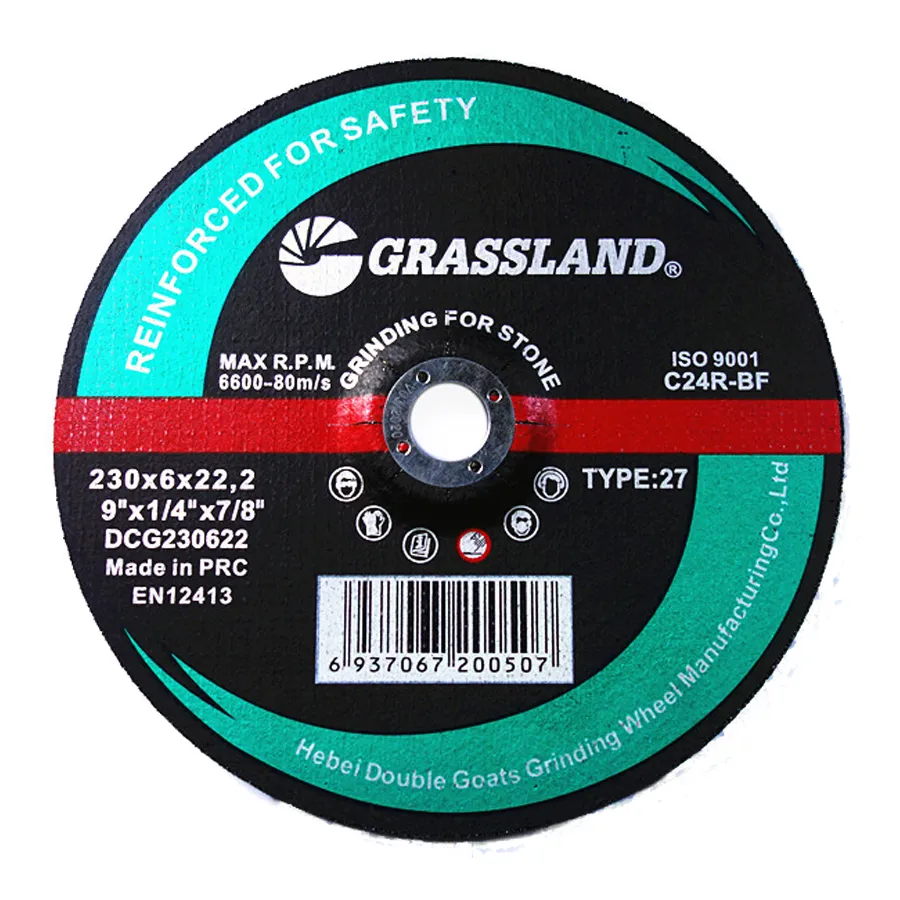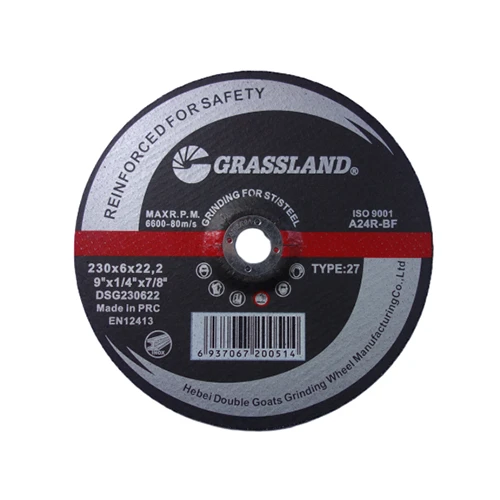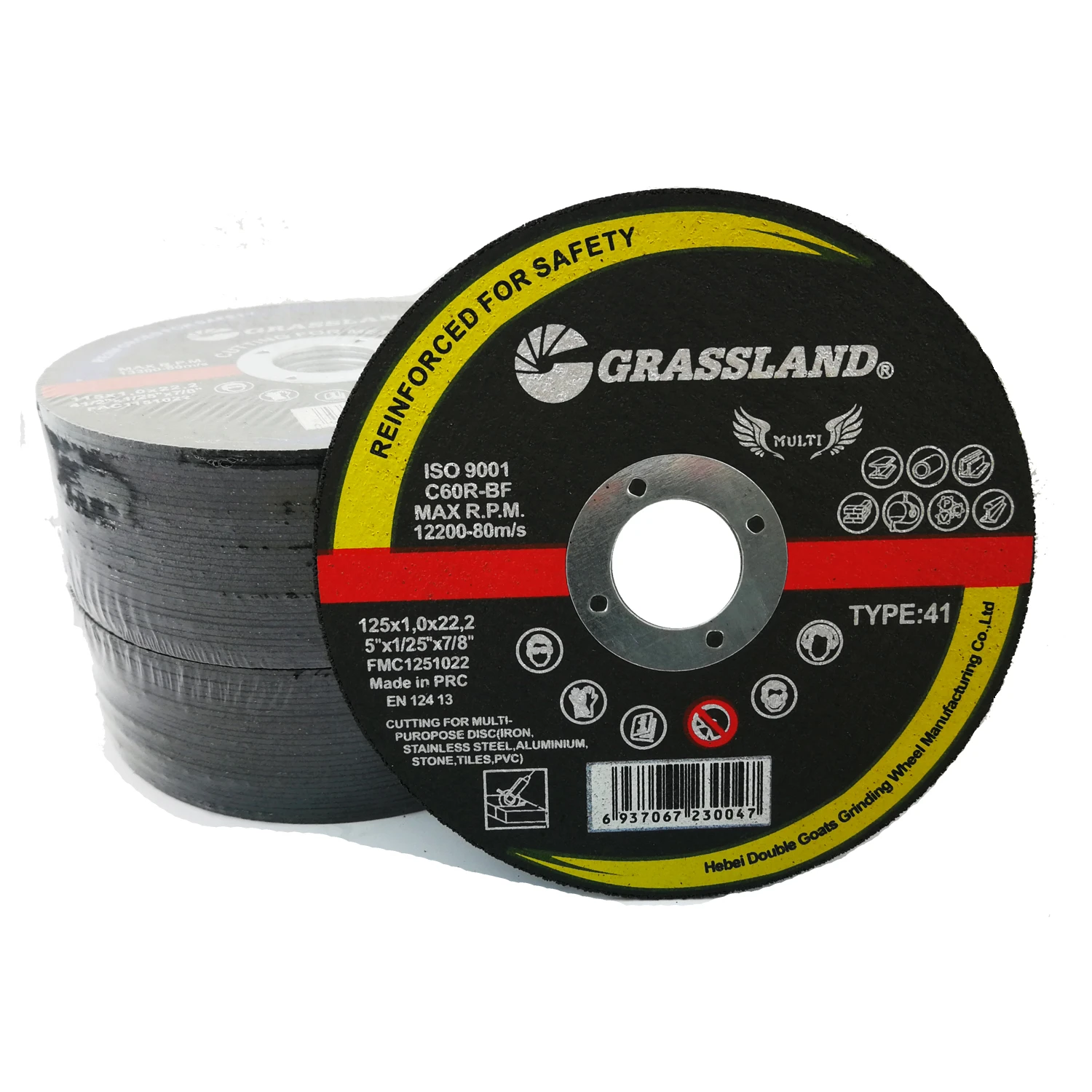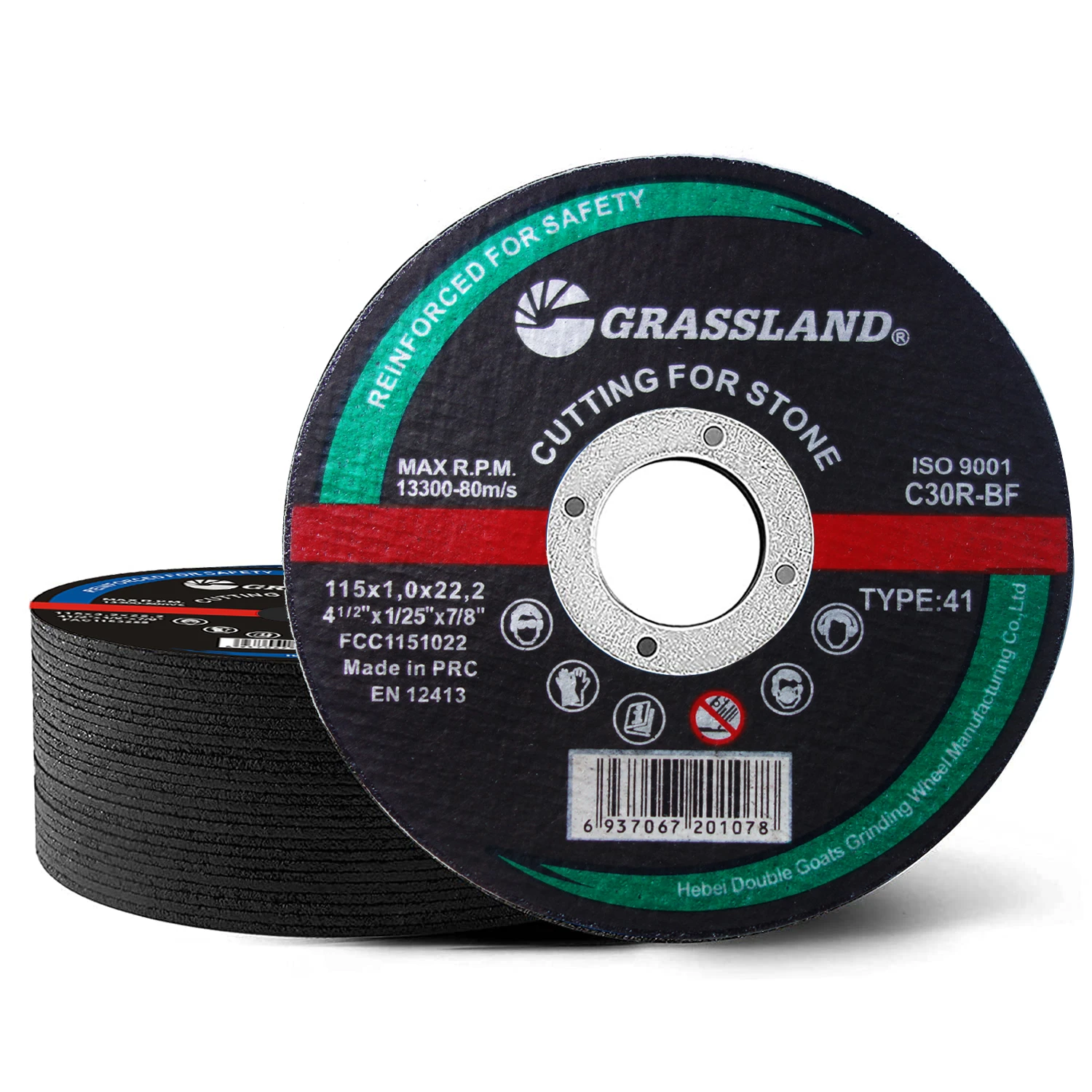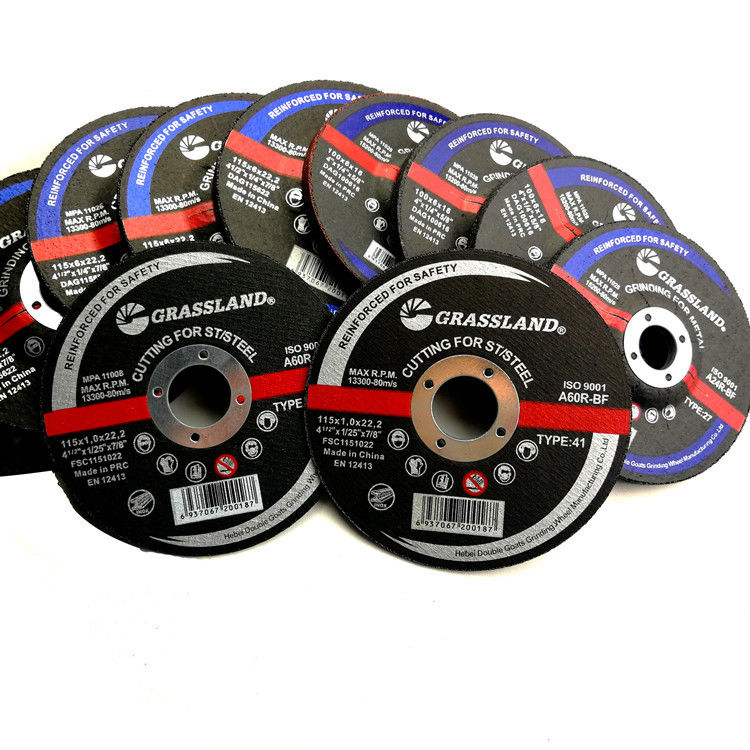In the demanding world of metal fabrication, construction, and industrial maintenance, the choice of abrasive tools significantly impacts efficiency, safety, and project quality. Among the most widely used and versatile tools is the 4.5 metal cutting disc. Renowned for its balance of maneuverability and cutting power, the 4.5 inch metal cutting wheel has become an indispensable asset for professionals tackling various metalworking tasks. This comprehensive guide delves into the intricate details of these essential tools, exploring their technological advancements, manufacturing precision, diverse applications, and what sets a superior product apart.
Current Industry Trends in Abrasive Technology
The abrasive industry is constantly evolving, driven by demands for higher performance, greater safety, and improved sustainability. Key trends shaping the development of the 4.5 cut off wheel include:
- Advanced Abrasive Grains: Beyond traditional aluminum oxide and silicon carbide, newer ceramic and zirconia alumina grains offer superior friability, self-sharpening properties, and extended tool life, especially for challenging materials like stainless steel and exotic alloys.
- Enhanced Bonding Systems: Innovations in resinoid bonding agents lead to stronger, more flexible, and heat-resistant discs, reducing material removal rates and preventing premature wear. This directly translates to the longevity of a 4.5 inch cutting disc.
- Thin Kerf Technology: Ultra-thin designs, like the Grassland 100mm Ultra Thin grinder disc for metal cutting disc 4, minimize material waste, reduce heat generation, and allow for faster, more precise cuts with less effort. This is particularly crucial for maintaining material integrity.
- Safety Features: Manufacturers are incorporating advanced safety features, including reinforced fiberglass mesh layers and improved balancing techniques, to prevent disc shattering and enhance operator safety. Adherence to standards like ANSI B7.1 and EN 12413 is paramount.
- Sustainability Initiatives: Efforts are underway to develop more environmentally friendly manufacturing processes and discs that produce less waste, aligning with global sustainability goals.
Technical Parameters and Specifications of 4.5 Metal Cutting Disc
Understanding the technical specifications of a 4.5 metal cutting disc is crucial for selecting the right tool for the job. These parameters directly influence performance, safety, and efficiency.
Key Parameters Explained:
- Diameter: Typically 4.5 inches (115mm or 100mm for specific markets like the Grassland 100mm Ultra Thin). This dictates the reach and cutting depth.
- Thickness (Kerf): Ranging from ultra-thin (0.045 inches / 1.0-1.2mm) to standard (0.0625 inches / 1.6mm or 0.094 inches / 2.4mm). Thinner discs offer faster cuts and less material loss, while thicker discs provide greater durability for tougher applications.
- Arbor Hole Size: Commonly 7/8 inches (22.23mm), ensuring compatibility with standard angle grinders.
- Maximum RPM (Revolutions Per Minute): A critical safety parameter, indicating the maximum rotational speed the disc can safely withstand without disintegrating. For a 4.5 metal cutting disc, this often ranges from 13,000 to 13,300 RPM. Always match or exceed the grinder's RPM rating.
- Abrasive Grain Type:
- Aluminum Oxide (A): Most common, versatile for general purpose cutting of carbon steel and mild steel. Offers good performance and cost-effectiveness.
- Zirconia Alumina (ZA): More durable and self-sharpening than aluminum oxide, ideal for tougher applications like stainless steel, cast iron, and high-tensile alloys.
- Ceramic Alumina (C): Premium grain, highly friable (breaks down to expose new sharp edges), providing exceptional cutting rates and long life on superalloys and hardened steels.
- Silicon Carbide (C): Primarily used for cutting non-ferrous metals (aluminum, brass, bronze) and masonry materials, though less common for dedicated metal cutting discs.
- Bonding Agent: Resinoid bonds (phenolic resin) are standard for cutoff wheels, providing strength and flexibility. The quality and composition of the bond significantly affect disc life and cutting speed.
- Reinforcement: Multiple layers of fiberglass mesh are embedded within the disc to provide structural integrity and prevent shattering, especially under side stress or impact.
- Grit Size: Refers to the size of the abrasive particles (e.g., 46 grit, 60 grit). Finer grits (higher numbers) provide smoother finishes, while coarser grits (lower numbers) offer faster material removal. For cutting, medium to coarse grits are common.
Typical Parameters for 4.5 Metal Cutting Disc
The table below provides a general overview of common parameters you might find for a 4.5 inch metal cutting wheel, including our featured Grassland 100mm Ultra Thin disc.
| Parameter | Typical Range for Standard 4.5" Disc | Grassland 100mm Ultra Thin (Example) | Significance | ||||
|---|---|---|---|---|---|---|---|
| Outer Diameter | 4.5 inches (115mm) | 4 inches (100mm) | Determines cutting depth and compatibility with grinders. | ||||
| Thickness | 0.045" - 0.125" (1.2mm - 3.2mm) | 0.043" (1.0mm) - 0.047" (1.2mm) | Thinner for faster, cleaner cuts; thicker for durability. | ||||
| Arbor Hole Size | 7/8 inches (22.23mm) | 7/8 inches (22.23mm) | Standard fit for angle grinders. | ||||
| Max RPM | 13,000 - 13,300 RPM | 15,200 RPM | Critical safety limit; must not be exceeded. | ||||
| Abrasive Type | Aluminum Oxide, Zirconia Alumina | Premium Aluminum Oxide / Zirconia blend | Determines performance on different metals. | ||||
| Bonding Type | Resinoid (BF) | High-Performance Resinoid (BF) | Influences disc strength, heat resistance, and life. | ||||
| Reinforcement Layers | 2-3 Fiberglass layers | Double Fiberglass Mesh | Enhances safety and structural integrity. | ||||
| Applicable Metals | Mild Steel, Stainless Steel, Alloys | Stainless Steel, Mild Steel, Various Metals | Versatility across different material types. | Standards Met | EN12413, ISO 9001, ANSI B7.1 | EN12413, ISO 9001 | Ensures quality, safety, and performance. |
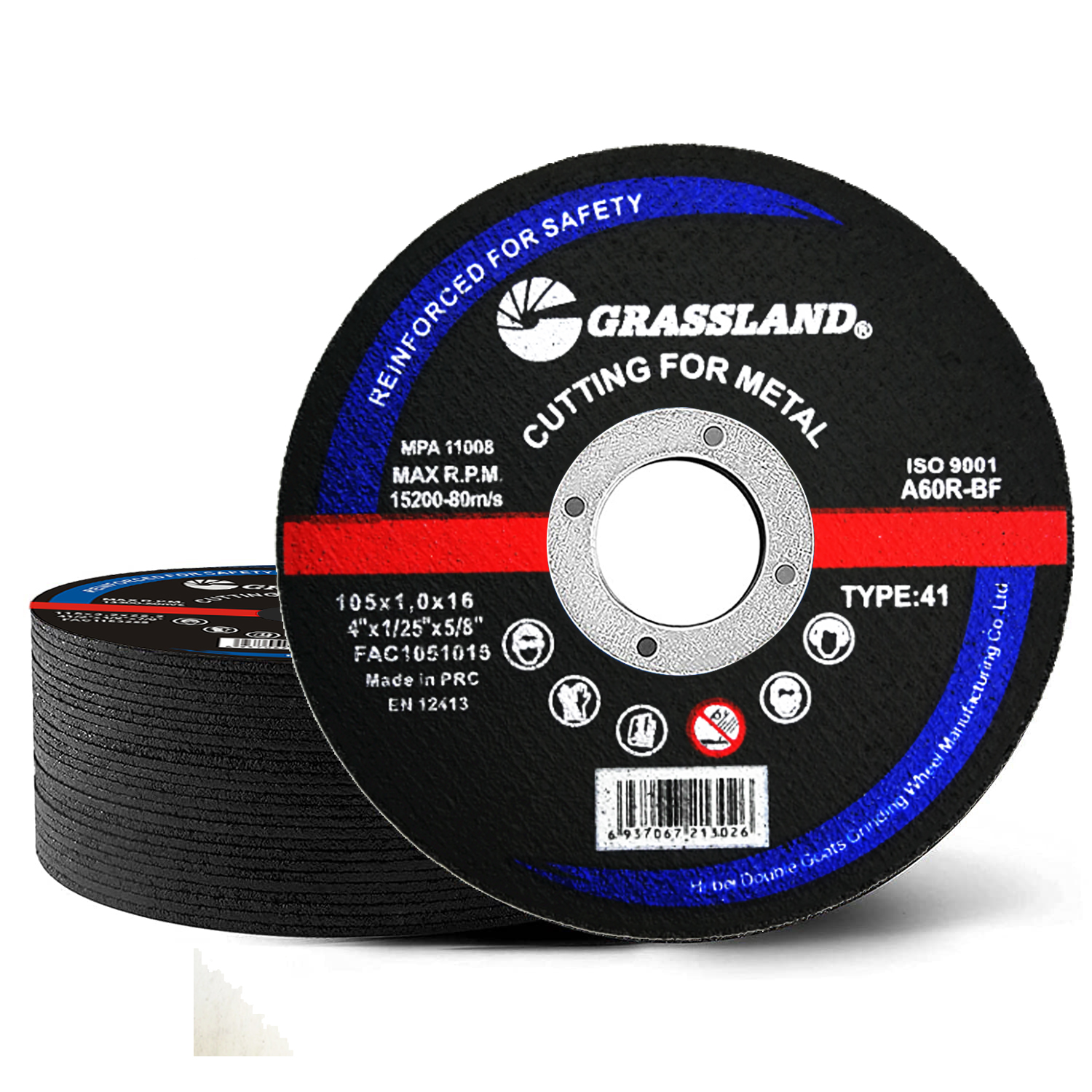
Manufacturing Process of a 4.5 Metal Cutting Disc: From Raw Materials to Precision Tool
The creation of a high-quality 4.5 metal cutting disc is a sophisticated process that combines material science with precision engineering. The Grassland 100mm Ultra Thin grinder disc for metal cutting disc 4 exemplifies adherence to stringent manufacturing protocols, ensuring consistent performance and safety. Here's a generalized overview of the manufacturing flow, emphasizing key stages:
- Raw Material Selection & Preparation:
- Abrasive Grains: High-purity aluminum oxide, zirconia alumina, or ceramic grains are sourced. These are selected based on the desired cutting performance, material compatibility, and cost. For Grassland, a blend of premium aluminum oxide and zirconia ensures optimal cutting for various metals.
- Bonding Agents: High-grade phenolic resins are prepared. These thermosetting polymers, when cured, bind the abrasive grains and reinforcement together.
- Reinforcement Materials: Woven fiberglass mesh layers are cut to size. These provide the essential tensile strength and burst resistance, crucial for the safety of any 4.5 cut off wheel.
- Fillers and Additives: Various fillers (e.g., cryolite, pyrite) and additives are incorporated to improve cutting performance, reduce heat generation, enhance disc life, and facilitate self-sharpening.
- Mixing:
The precisely measured abrasive grains, bonding resins, fillers, and additives are thoroughly mixed in large industrial mixers. This ensures a homogeneous distribution of all components, vital for the disc's consistent performance and balance.
- Forming (Pressing):
The mixed compound is fed into high-pressure hydraulic presses. Pre-cut fiberglass reinforcement layers are strategically placed within the mix. For a 4.5 inch cutting disc, the material is pressed into the desired circular shape and thickness under immense pressure. This compacts the material, creating a dense and uniform structure. The arbor hole is also formed during this stage.
- Curing (Baking/Brazing):
The "green" (uncured) discs are transferred to specialized ovens for a controlled curing process. Under specific temperature and time profiles (typically involving slow heating, holding, and cooling cycles), the phenolic resin bonds polymerize and harden, creating a strong, durable bond that holds the abrasive grains firmly in place. This thermal treatment is critical for developing the disc's final strength and performance characteristics. This stage is akin to the "baking" in ceramic manufacturing, giving the disc its final hardness and structural integrity.
- Finishing & Balancing:
After curing, the discs undergo finishing processes, which may include trimming excess material, grinding the sides for perfect parallelism, and ensuring the arbor hole is precise. Crucially, each disc is balanced to prevent vibrations during operation, which can lead to premature wear, poor cut quality, and safety hazards. Unbalanced discs can cause excessive runout and stress on the grinder.
- Quality Control & Inspection:
Rigorous quality control measures are implemented throughout the process. Post-curing, discs undergo a series of tests:
- Dimensional Inspection: Checking diameter, thickness, and arbor hole accuracy.
- Static Balance Test: Ensuring the disc is balanced.
- Run-out Test: Measuring the wobble during rotation.
- Burst Speed Test: A critical safety test where discs are spun at speeds significantly higher than their maximum rated RPM to ensure they can withstand extreme forces without disintegrating. This confirms compliance with standards like EN 12413 and ANSI B7.1.
- Cutting Performance Test: Random samples are subjected to actual cutting tests on various materials to verify cutting speed, disc life, and burr formation.
Grassland products, including the 100mm Ultra Thin grinder disc, adhere to international standards such as ISO 9001 for quality management and EN 12413 for safety requirements of bonded abrasive products, ensuring reliability and high performance.
- Labeling & Packaging:
Finally, discs are labeled with essential information (size, RPM, abrasive type, safety warnings) and packaged for shipment. Proper packaging protects the discs from damage and moisture.
This meticulous process ensures that each 4.5 metal cutting disc leaving the factory is a precision tool capable of delivering consistent, safe, and efficient performance across a wide range of industrial applications.
Application Scenarios and Industry Use Cases
The versatility of the 4.5 metal cutting disc makes it an indispensable tool across numerous industries:
- Construction: Cutting rebar, steel studs, angle iron, metal decking, roofing materials, and structural steel components. A 4.5 inch metal cutting wheel is a common sight on construction sites due to its portability and cutting power.
- Metal Fabrication Shops: Precision cutting of steel plates, tubes, pipes, and profiles for custom projects, welding preparation, and general fabrication. The Grassland 100mm Ultra Thin disc excels here, offering clean cuts for welding without excessive burr.
- Automotive Industry: Cutting exhaust pipes, chassis components, body panels for repairs, modifications, and restoration work. Its compact size allows access in tight spaces.
- Shipbuilding: Cutting steel plates and profiles for ship structures, repairs, and modifications in confined spaces.
- Oil & Gas / Petrochemical: Maintenance, repair, and overhaul (MRO) tasks involving pipelines, structural steel, and equipment in harsh environments. Discs used here often need to meet stringent safety and material compatibility requirements.
- Mining & Quarrying: Cutting thick metal components, rails, and machinery parts during maintenance or installation.
- Agricultural Equipment Repair: Cutting and shaping metal components for farm machinery, tools, and irrigation systems.
- HVAC Installation: Cutting metal ductwork, vents, and other sheet metal components.
- Plumbing and Pipefitting: Cutting various types of pipes, including steel, cast iron, and even some plastic pipes (with appropriate disc types).
In all these scenarios, the key advantages of a high-quality 4.5 cut off wheel are its ability to make quick, clean cuts, often with minimal heat distortion, reducing the need for extensive post-cut finishing.
Technical Advantages of High-Performance 4.5 Metal Cutting Discs
Investing in a premium 4.5 metal cutting disc like the Grassland 100mm Ultra Thin grinder disc offers significant technical advantages:
- Exceptional Cutting Speed: Advanced abrasive grains and optimized bonding systems allow for rapid material removal, significantly reducing cutting time. The ultra-thin profile of Grassland discs minimizes friction, leading to faster cuts.
- High Precision and Clean Cuts: Thin kerf designs produce narrow, clean cuts with minimal burr. This reduces post-cutting cleanup and rework, saving labor and time.
- Reduced Heat Generation: Efficient cutting action and thinner profiles mean less friction and less heat transfer to the workpiece. This is crucial for heat-sensitive materials like stainless steel, preventing discoloration and material distortion.
- Extended Disc Life: Superior abrasive grains (e.g., Zirconia Alumina, Ceramic) and durable bonding agents ensure longer operational life, reducing the frequency of disc changes and lowering overall consumable costs.
- Enhanced Safety: Multi-layer fiberglass reinforcement and rigorous burst speed testing (per EN 12413 standards) provide superior safety, greatly reducing the risk of disc shattering during demanding applications.
- Versatility: A single high-quality 4.5 metal cutting disc can often be used effectively on various ferrous metals, from mild steel to stainless steel and alloys, simplifying inventory and tool selection.
- Ergonomic Benefits: Faster cutting and less effort required translate to reduced operator fatigue, improving productivity and safety.
Manufacturer Comparison and Selection Criteria
Choosing the right manufacturer for your 4.5 inch metal cutting wheel is as important as selecting the disc itself. Here's what to consider:
- Quality Control & Certifications: Look for manufacturers with ISO 9001 certification (for quality management) and adherence to abrasive safety standards like EN 12413 (European) and ANSI B7.1 (American). These certifications indicate a commitment to consistent quality and safety.
- Material Science Expertise: Leading manufacturers invest in R&D to develop superior abrasive grain compositions and bonding systems. Their ability to innovate directly translates to better performing and longer-lasting discs.
- Product Range: A diverse product range indicates comprehensive industry knowledge, offering specialized discs for different materials and applications (e.g., thin discs for stainless steel, thicker discs for heavy-duty cutting).
- Customer Support & Technical Assistance: A reputable manufacturer provides excellent pre-sales consultation and post-sales support, including guidance on disc selection, usage best practices, and troubleshooting.
- Industry Reputation & Experience: Manufacturers with a long history and strong reputation in the abrasive industry often signify reliability and proven performance. Grassland, for instance, has years of experience delivering high-performance abrasive solutions.
- Sustainability Practices: Increasingly, manufacturers are adopting environmentally friendly practices in their production processes.
While a detailed competitive comparison table might vary based on specific product lines, focusing on these criteria helps identify top-tier providers. For example, comparing the burst speed rating, reported disc life (based on tests), and type of abrasive grain used can quickly differentiate a premium 4.5 metal cutting disc from a generic one.
Customization Solutions for Specific Applications
Beyond standard offerings, many manufacturers, including those producing the Grassland 100mm Ultra Thin grinder disc, can provide customized solutions for specialized industrial needs. This is particularly valuable for large-scale operations or unique material challenges.
- Tailored Abrasive Blends: Developing specific blends of abrasive grains (e.g., higher concentration of Zirconia Alumina for heavy-duty alloy cutting) to optimize performance for a particular material.
- Custom Thickness & Diameter: While 4.5 inches is standard, specific applications might benefit from slightly different diameters or thicknesses to achieve optimal cutting efficiency or access.
- Special Bonding Systems: Modifying the resinoid bond to enhance heat resistance for continuous cutting applications or to provide greater flexibility for shock resistance.
- Color Coding & Branding: For large clients, discs can be customized with specific color codes or branding for easier identification and inventory management.
- Specialized Reinforcement: Adding extra layers of reinforcement or using advanced composite materials for extreme safety requirements or high-impact applications.
Consulting with the manufacturer's technical team is crucial to develop a customized solution that perfectly matches your operational requirements, ensuring maximum efficiency and safety.
Real-World Application Cases and Customer Experience
The practical utility of the 4.5 inch cutting disc is best illustrated through its application in various projects, showcasing its "experience" and proving its worth:
Case Study 1: Structural Steel Fabrication for a Commercial Building
A leading steel fabricator in Texas was struggling with slow cutting speeds and excessive disc consumption when processing various steel beams and columns (A36, A572 Grade 50) for a new commercial building. Their existing 4.5 metal cutting disc options were causing bottlenecks in production. Upon switching to the Grassland 100mm Ultra Thin grinder disc for metal cutting disc 4, they observed a dramatic improvement. The thin kerf allowed for faster cuts on thick profiles, reducing cutting time by 20%. The premium abrasive blend meant fewer disc changes, leading to a 30% reduction in abrasive consumable costs over a quarter. The clean cuts also minimized grinding time for weld preparation, enhancing overall productivity.
Case Study 2: Pipeline Maintenance in the Oil & Gas Sector
An MRO team working on a remote oil pipeline in Alberta, Canada, required a reliable 4.5 cut off wheel capable of cutting through hardened steel pipes in challenging weather conditions. Their primary concerns were disc durability, safety, and consistent performance. After adopting a batch of Grassland's specialized 4.5-inch discs, they reported excellent results. The discs demonstrated exceptional life even in cold temperatures, and the superior bonding system withstood the vibrations and stresses inherent in field work. The team specifically lauded the consistent burst resistance, which significantly enhanced worker confidence and safety on critical infrastructure projects, meeting stringent industry safety standards.
Customer Feedback Highlight:
"We’ve been using Grassland 4.5 inch metal cutting wheels for our custom gate and railing projects, and the difference is night and day. The cuts are so much cleaner, and we spend less time deburring. Plus, they last longer than any other disc we've tried. It's a game-changer for our small fabrication shop." - J. Smith, Owner of Elite Metalworks
These examples underscore how the technical superiority and robust manufacturing of products like the Grassland disc translate directly into tangible benefits for users in diverse, demanding environments.
Ensuring Trustworthiness: FAQ, Delivery, and Warranty
At Grassland, we believe in transparency and commitment to our customers, bolstering the "Trustworthiness" aspect of our products and services.
Frequently Asked Questions (FAQ) about 4.5 Metal Cutting Discs:
- What is the primary material composition of a 4.5 metal cutting disc?
A typical 4.5 metal cutting disc is primarily composed of abrasive grains (such as aluminum oxide or zirconia alumina), a thermosetting resinoid bonding agent (e.g., phenolic resin), and multiple layers of fiberglass reinforcement mesh for strength and safety. Fillers and cryolitic salts may also be added to enhance cutting performance and reduce heat. - What does "ultra-thin" mean for a 4.5-inch cutting disc, and what are its benefits?
"Ultra-thin" typically refers to discs with a thickness of 1.0mm to 1.2mm (0.039" to 0.047"). Benefits include faster cutting speeds due to less material resistance, reduced material waste (narrower kerf), lower heat generation preventing workpiece distortion, and less strain on the angle grinder and operator. - Can a 4.5-inch metal cutting disc be used on stainless steel?
Yes, a 4.5 metal cutting disc specifically designed for stainless steel (often marked "INOX" or with a special abrasive blend like zirconia alumina) can be used. These discs minimize contamination and heat buildup, which are crucial for preventing discoloration and corrosion in stainless steel. The Grassland 100mm Ultra Thin is specifically engineered for excellent performance on stainless steel. - What is the maximum safe operating speed (RPM) for a 4.5 metal cutting disc?
The maximum safe operating speed (RPM) is typically indicated on the disc label and should never be exceeded. For a 4.5 inch cutting disc, this is often between 13,000 to 13,300 RPM. Always ensure your angle grinder's RPM does not exceed the disc's maximum rated RPM. Our Grassland 100mm Ultra Thin disc has a higher safety rating of 15,200 RPM. - How do I ensure safety when using a 4.5 cut off wheel?
Always wear appropriate Personal Protective Equipment (PPE), including safety glasses, hearing protection, gloves, and a face shield. Ensure the disc is correctly mounted, guard is in place, and the disc's RPM rating matches or exceeds the grinder's. Avoid side grinding, always cut in a straight line, and never use a damaged disc. Follow ANSI B7.1 or EN 12413 guidelines. - What's the difference between an aluminum oxide disc and a zirconia alumina disc of the same size?
Aluminum oxide discs are general-purpose, cost-effective, and ideal for mild steel and carbon steel. Zirconia alumina discs are more durable, self-sharpening, and excel on tougher materials like stainless steel, high-tensile alloys, and cast iron, offering longer life and faster cuts on these materials. - What is the expected shelf life of a 4.5 metal cutting disc?
Most bonded abrasive discs have a shelf life of approximately 3-5 years from the date of manufacture, provided they are stored correctly in a dry, temperature-controlled environment away from moisture and extreme temperatures. Discs past their expiry date may have degraded bonding agents and should not be used.
Delivery Cycle & Global Reach:
Understanding the logistical aspects is vital for industrial procurement. Grassland maintains efficient supply chain management to ensure timely delivery of your 4.5 metal cutting disc orders. For standard orders, typical delivery within North America and Europe ranges from 5-10 business days. For larger, customized, or international orders, a detailed delivery schedule will be provided upon inquiry, factoring in sea or air freight options. We partner with reputable logistics providers to ensure your products arrive safely and on schedule.
Quality Assurance & Warranty Commitment:
Every Grassland 100mm Ultra Thin grinder disc for metal cutting disc 4 is manufactured under stringent ISO 9001 certified quality management systems and rigorously tested to meet EN 12413 safety standards. We stand by the quality and performance of our products. Grassland offers a standard 12-month warranty against manufacturing defects from the date of purchase. Our dedicated customer support team is available to assist with any product-related queries or issues, ensuring peace of mind and demonstrating our commitment to client satisfaction.
Conclusion: The Enduring Significance of the 4.5 Metal Cutting Disc
The 4.5 metal cutting disc, epitomized by advanced products like the Grassland 100mm Ultra Thin grinder disc for metal cutting disc 4, remains a cornerstone of efficiency and safety in metalworking. Its evolution, driven by advancements in material science, manufacturing precision, and adherence to global safety standards, ensures that professionals continue to have access to tools that meet the rigorous demands of modern industry. From high-speed cutting in fabrication shops to critical maintenance in petrochemical plants, the right 4.5 inch metal cutting wheel delivers unparalleled performance, significantly impacting project timelines, costs, and safety records. By understanding the intricate details of their construction, application, and the rigorous standards they must meet, users can make informed choices that elevate their operational capabilities and productivity.
For further insights into abrasive technology and safety, we recommend consulting authoritative industry resources:
- Abrasive Engineering Society (AES) - Offers educational resources and industry best practices. (Note: Specific URL for public resources might vary, search 'Abrasive Engineering Society').
- Unified Abrasives Manufacturers' Association (UAMA) - Provides standards and technical information for abrasive products. https://www.uama.org/
- British Abrasives Federation (BAF) - Key source for European safety standards (EN 12413). https://www.baf.org.uk/
- OSHA (Occupational Safety and Health Administration) - Provides safety guidelines for abrasive wheel use. Search for "OSHA abrasive wheels".
Post time:Aug - 09 - 2025







